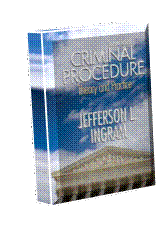
 |
Criminal Procedure
|
 |
 |
 |
 |
|||||
Preface
The field of criminal procedure provides part of the matrix of fairness and justice that promotes equality of treatment for persons suspected or accused of crime; therefore, it occupies an important position in the field of criminal justice. Since its genesis comes from both the Constitution of the United States and the constitutions of the several states, its substance and application will vary in some fashion from jurisdiction to jurisdiction. The decisions made by the Supreme Court of the United States, when speaking on federal constitutional issues, are binding on state criminal justice practice. Although constitutional decisions are mandatory on the states, such decisions dictate the minimal legal protections required under our federal system. Every state may go beyond the basic minimum federal guarantees by offering an accused enhanced or greater state constitutional rights. For example, a state is free to allow vicarious standing to suppress evidence following a Fourth Amendment violation, or it may require the presence of a parent or guardian before a juvenile may waive Miranda rights. States also may grant enhanced criminal procedure protections based on considerations of state appellate case law and state statutory law.
The constitutional and statutory rules that make up the body of law known as criminal procedure regulate how state and federal governments must treat persons accused or suspected of committing crimes. Rules dictating the way law enforcement officials interact with individuals who are mere suspects for particular crimes restrain their activities and approaches prior to the initiation of formal criminal prosecutions. When investigations have moved beyond their initial stages to the point where criminal suspects have been identified, the rules of criminal procedure provide a road map that all law enforcement officials must follow. Where officials fail to observe recognized criminal procedural rules, such deviation may jeopardize any eventual successful criminal prosecution by creating the conditions that require the suppression of otherwise admissible trial evidence or by opening any eventual conviction to appellate attack.
Similarly, when law enforcement officials have turned their work product over to the prosecutor's office, the personnel presenting the government's case must carefully follow additional rules regulating fair conduct in order to accord due process to the accused. The prosecution has no duty to win a case at all costs; it possesses the overall obligation to see that justice is the eventual outcome of the trial process. Defense attorneys have a role within the rules of criminal procedure to ensure that the government has played fairly during the investigation, pretrial, and trial phases; they also are obligated to provide a vigorous defense consistent with the Constitution and state rules and regulations.
During criminal trials, judges must carefully weigh the arguments of the contending parties, whether they are arguing over criminal procedural issues relative to the admission or exclusion of evidence or over more traditional admission of evidence under evidence codes. Whether a judge presides over pretrial issues, the trial itself, or post-trial motions or serves on an appellate panel reviewing trial-level judicial decisions, every judge possesses a duty of due process to both the prosecution and the defense. Roughly translated, due process implies fundamental fairness and fair dealing to all parties during all the important stages of the criminal justice process.
While the study of criminal procedure typically follows the case study method of instruction, where students are exposed to appellate decisions using real-world problems, this book brings together both the richness of textual description and edited appellate cases. The latest case material is available to the student at http://www.criminalprocedurebyingram.com , which presents edited, updated legal cases that coordinate with the book's table of contents. When a new decision by the Supreme Court of the United States alters or modifies a criminal procedure concept covered by this book, the new edited case will be placed on the book's Web site in a matrix that coordinates the new material with the respective chapter. Having the book's Web resource enables the student to both learn the traditional case precedents and integrate those principles with the latest court decisions covering a particular topic of criminal procedure.
The most significant developments, changes, and corrections in criminal procedure have generally come from landmark case decisions of the Supreme Court of the United States. Implementation of the rules contained within Supreme Court case decisions has largely been delegated to state legal systems, where state courts have developed slightly divergent interpretations and applications of these legal principles. The Federal Rules of Criminal Procedure and state rules of criminal procedure owe much of their content to the codification of legal principles announced by the Supreme Court of the United States and to common-law practice. Many states have adopted local versions of rules for criminal procedure based substantially or loosely on the Federal Rules of Criminal Procedure.
The beginning chapters of this book offer historical lessons about the Bill of Rights and the significant constitutional alterations that followed the American Civil War (1861-1865) that may not be well known to many students. The introductory chapters of the book allow the student to develop a historical context for many of the important concepts and theories in criminal procedure, as well as gain knowledge about the direction in which courts may take recent jurisprudence and build for the future. Knowledge of past legal history helps the current student or attorney appreciate the legacy that historical figures have left to this generation. Subsequent chapters detail police, attorney, and judicial practices that have developed since the adoption of the Constitution of the United States. It is the implementation of constitutional and case law principles and changes that drive most of modern criminal procedure and which the individual chapters present in an ongoing and dynamic fashion.
Jefferson L. Ingram
University of Dayton
February 2008
Contact Us | Website ©2008 Jefferson Ingram. Last updated
August 30, 2008
. Webmaster: L. Ingram.